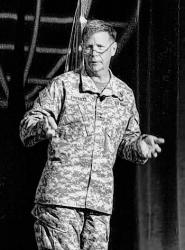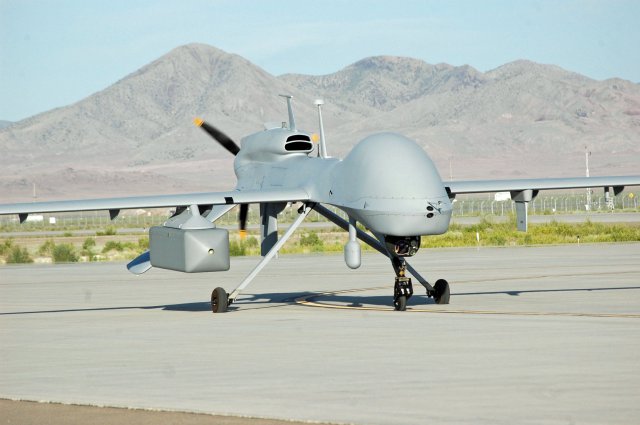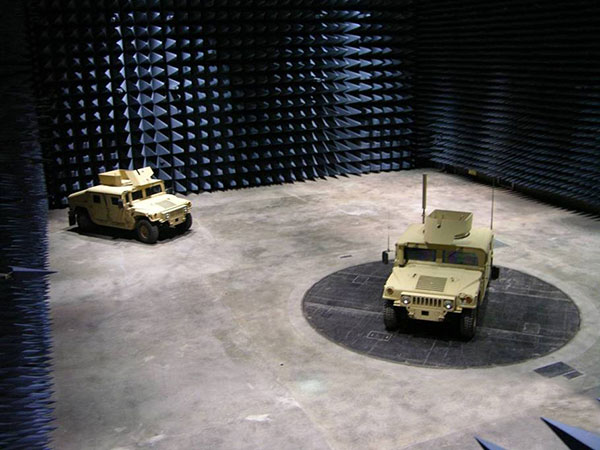Army Electronic Warfare ‘Is A Weapon’ – But Cyber Is Sexier
Posted on
WASHINGTON: “Electronic warfare is a weapon,” fumed Col. Joe Dupont. But as the Army’s project manager for EW programs — and its recently declassified offensive cyber division — Dupont faces an uphill battle against tight budgets and Army culture to make that case.
Whoever rules the airwaves will be able to keep their networks and sensors working while shutting down the enemy’s — or subverting them. As the world goes wireless, both phones and computers depend increasingly on radio links rather than physical cables: an iPhone is, at its core, a radio. That means jamming and hacking, traditional electronic warfare and the brave new world of cyber, are beginning to blur together.
I ran into Dupont at last week’s Association of Old Crows conference, where the tribe of experts in jamming, spoofing, radio, and radar gather — among other reasons — to be barraged by abstruse PowerPoint slides. “One of the bullets I saw up there [said] ‘EW enables weapons systems,'” Dupont said. “Completely false statement. EW is a weapon system.”

Col. Joe Dupont
“There’s nothing sexy about the enablers. We’ve got to stop talking about it as an enabler. It’s a weapon system,” Dupont said. “It is fires!”
Equating radar and radio jamming to artillery fire, missiles, and airstrikes (collectively, “fires”) has top-level endorsement in the Navy, where Chief of Naval Operations Adm. Jonathan Greenert wants the fleet to practice “electromagnetic maneuver warfare.” In the Army, however, the concept is just starting to take root.
The largest service essentially got out of the electronic warfare business in the 1990s after the Soviet threat collapsed, and then had to scramble to rebuild it when Iraqi insurgents started killing soldiers with radio-detonated roadside bombs. Today, the Army boasts a massive inventory of vehicle-mounted Counter-Radio-Controlled IED (CREW) jammers (“32,608,” Dupont said, “but who’s counting?”), “a couple thousand” portable versions, “ten or so” fixed EW installations, and a handful of aircraft using modified Navy jamming gear.
While the overwhelming focus so far has been defense against improvised explosive devices (IEDs), electronic warfare can be used much more aggressively. In a recent Army experiment called Black Dart, for example, a jury-rigged jammer shut down an “enemy” drone. Navy and Air Force jammers routinely blind radars and disrupt communications at long range, capabilities the Army currently lacks. Meanwhile, potential adversaries from terrorists to the Russian Army are investing in electronic warfare gear designed to target the US military’s dependence on digital data, such as drone control links and GPS signals: The US will need a way to jam them before they can jam us.
Many electronic warriors fear they’ll be left behind as money, talent, and top-level attention pour into the sexier field of cyber war. The new Army Operating Concept (AOC) mentions “cyber” and “cyberspace” roughly 50 times; “electronic warfare” or “EW,” only once.

Maj. Gen. Stephen Fogarty
Never fear, the head of the Army’s new Cyber Center assured me when I asked him this question yesterday at the annual Association of the US Army conference. “The road ahead is full integration, not [EW] tagging along as an afterthought,” said Maj. Gen. Stephen Fogarty. He heads what was formerly the Army signal corps headquarters at Fort Gordon, Ga., which now oversees both cyber and electronic warfare as well. Unlike joint doctrine on the subject, Fogarty said pointedly, the Army’s Cyber/Electromagnetic Activities (CEMA) field manual issued in February explicitly joins cyber and electronic warfare. On the acquisition side, meanwhile Dupont’s office oversees not only traditional EW programs but also a division developing offensive cyber, although he provided no details because until recently everything it’s been doing — even its existence — has been classified.
This convergence of cyber and EW is already happening in the real world. Way back in 2007, the Israelis reportedly used US wireless hacking technology to blind Syrian air defenses during their “Operation Orchard” raid on Syria’s secret nuclear plant. Electronic warfare transmitters can be “the gun that fires the bullet” of a computer virus into an enemy network, said Dupont’s civilian deputy, Mike Ryan: “We’ve already demonstrated it, about a year ago. Some real neat stuff.”
That was using the existing short-range systems, however. For the future, if budgets hold, the Army will develop a family of long-range offensive jammers, starting with one mounted on a Shadow drone. The contract for this Multi-Functional Electronic Warfare (MFEW) system is to be awarded in 2018. The Army will also need to develop a new defensive jammer for when the current CREW Dukes start reaching “end of useful life” around 2021-2022.

The Army’s NERO program tested a converted Navy jammer on a Grey Eagle drone, the Army version of the Predator.
EW’s Stock ‘Will Go Through The Roof’
What Dupont’s office has in the works right now seems much more modest: not a new piece of hardware, just a software package. After a year of contract disputes, the Army recently awarded Raytheon a contract for an Electronic Warfare Planning and Management Tool (EWPMT), a deceptively bland name for what Ryan calls “the backbone and future for all future Army EW.”

Lt. Col. Joyce Stewart
Despite the year’s delay, EWPMT is on track to meet all its procurement milestones, the product manager, Lt. Col. Joyce Stewart, assured me: “We have already begun doing our design reviews” with Raytheon in preparation for the official Critical Design Review. The first, bare-bones version of EWPMT is supposed to enter service in 2016, with five successive upgrades following at 12 to 15 month intervals. Funding over five years is a modest (by Pentagon standards) $98.7 million.
Why does a “planning and management tool” come first? Because in an era when Army commanders can track and talk to every vehicle and, soon, every squad of foot troops — capabilities entirely dependent on uninterrupted radio communications — the electronic warriors who would actually fight for those frequencies must make do with Microsoft PowerPoint and acetate overlays.
“They’re doing things on the back of the napkin right now,” said Ryan. “They work with spreadsheets and PowerPoint, and they know what the CREW devices do, but they have nothing to do that asset management, that modeling and simulation pre-mission to estimate effects on targets….EWPMT’s going to take care of that.”
EWPMT will give its users rapid access to a range of Army databases, from intelligence (such as DCGS-A) to electromagnetic spectrum management (Spectrum-21). The planning and management software itself will runs on the service’s existing command-and-control equipment. That means electronic warfare officers will finally get full access to the system that their peers from infantry to artillery to logistics use to exchange data, issue orders, and draw up plans. Most dramatically, EWOs will be able to display the effects of their weapons — adjusted for intervening terrain and other real-world factors — overlaid on the same computer maps commanders use to direct physical operations.

Col. James Ekvall
“Their stock in the maneuver commander’s eyes… will go through the roof,” Army Col. Jim Ekvall told reporters at the AUSA conference, because the commander will finally be able to see exactly what electronic warfare can do for him. “What we’ve put into the field is a bunch of electronic warfare professionals,” he said, “but we haven’t provided them any tool that allows them to visualize this capability or what the environment looks like.”
“That’s why it’s critically important” to field EWPMT “as quickly as we can,” said Ekvall, an EW expert on the Army headquarters staff, “if we want to convince a maneuver commander of the value of electronic warfare.”
Besides automating the collection and presentation of data for planning operations, EWPMT will eventually grow into a way to control electronic warfare systems during operations, such as the future drone-mounted jammer. “EWPMT is going to orchestrate the EW battle,” Ryan said. To do that in near-real time, however, he said, “depends on having sensors in our network” — and right now they’re not. “Our CREW jammers, they’re fantastic sensors,” he said, but they can’t talk to each other or anyone else: Each CREW-equipped vehicle or soldier exists in an isolated bubble, unable to share data on what they’re detecting and what they’re doing.
The Army is upgrading some CREW systems, and the latest version can communicate over a network. With troop levels in Afghanistan and the military budget both coming down, however, “there’s no plan to field it, not until needed,” Dupont said. “We’re only equipping one BCT with the latest and greatest” — a brigade combat team of the 82nd Airborne, the Army’s quick reaction Global Response Force — “and some additional boxes will be available for the Army Contingency Force” — the most ready brigades in separate-and-unequal tiered readiness system imposed by tightening budgets.

Lt. Gen. Edward Cardon, chief of Army Cyber Command.
“EW is a critical capability that we have to protect,” Lt. Gen. Ed Cardon, chief of Army Cyber Command, told me at the AUSA conference. What its role and relationship to cyber will be, however, are open questions. “The best way to work this is with experimentation,” Cardon told me, ideally in real-world training centers like White Sands Missile Range but at a minimum in the lab.
“Get something and start experimenting with it,” Cardon urged. Given the small budget and long timeline for introducing new Army electronic warfare gear, however, “getting something” may be a challenge in itself.
Subscribe to our newsletter
Promotions, new products and sales. Directly to your inbox.

